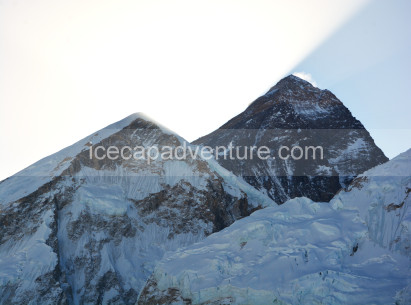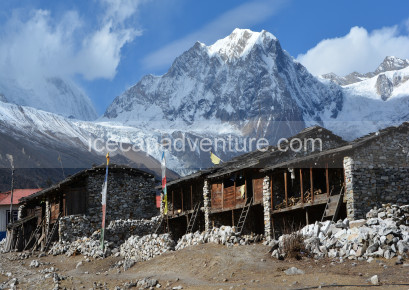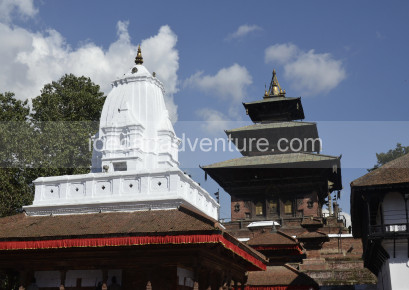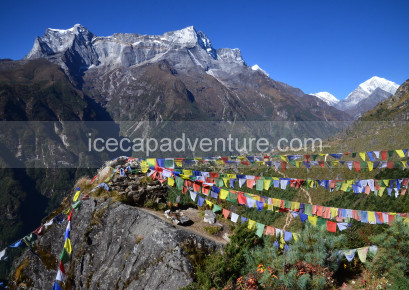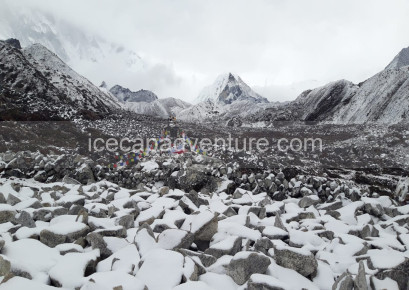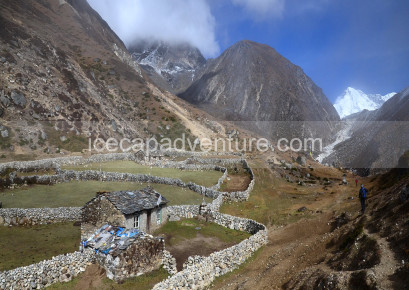.png)
.png)
.png)
.png)
.png)
.png)
.png)
.png)
Unveiling Tsorolpa (Tso Rolpa) Lake Trek: A Hidden Gem for Adventure Seekers
Introduction to Tsorolpa Lake Trek
Nestled in the pristine Rolwaling Valley of the Nepal Himalayas lies the breathtaking Tsorolpa (Tso Rolpa) Lake, one of the largest glacial lakes in Nepal. Surrounded by majestic peaks and tranquil landscapes, this trek is a true hidden gem for adventure seekers who wish to experience the raw beauty of nature. The journey to Tsorolpa Lake is not only about reaching the turquoise waters but also about immersing yourself in untouched wilderness, vibrant local culture, and awe-inspiring Himalayan panoramas.
Discovering the Hidden Gem
The Tsorolpa Lake Trek takes you through diverse terrains—dense forests, roaring rivers, traditional Sherpa villages, and high alpine meadows. Each day of the trek unveils new scenery, from cascading waterfalls to panoramic views of snow-clad mountains. The tranquillity of the lake, coupled with the serenity of the Rolwaling Valley, makes this journey a magical escape into nature’s finest creations.
Why Choose the Tsorolpa Lake Trek?
For trekkers looking to explore off-the-beaten-path destinations, the Tsorolpa Lake Trek is a must-do. The rugged trails, steep ascents, and challenging terrain provide a thrilling adventure, while the opportunity to camp under starlit skies near the lake adds an unforgettable charm. This trek perfectly blends adventure, cultural encounters, and natural beauty, making it ideal for those who crave an authentic Himalayan experience.
Best Time to Visit
The ideal seasons for the Tsorolpa Lake Trek are autumn (September–November) and spring (March–May). During these months, trekkers enjoy stable weather, crystal-clear skies, and pleasant temperatures. The monsoon (June–August) should be avoided due to slippery trails and landslide risks, while winter (December–February) brings harsh weather and snow-covered paths, making the trek more challenging.
Essential Trekking Tips
-
Pack Smart: Carry sturdy boots, layered clothing, and reliable trekking gear.
-
Stay Hydrated: Bring a reusable water bottle and drink plenty of water.
-
Acclimatize Properly: Take time to adjust to altitude to minimize the risk of AMS.
-
Respect Nature & Culture: Follow Leave No Trace principles, avoid littering, and respect local traditions.
-
Safety First: Start early, pace yourself, and stay on marked trails. Always inform someone of your itinerary.
Navigating the Trail
The trek requires a good understanding of the route, with marked trails and local guidance available. Carry a detailed map or GPS, and pay attention to trail signs. The trek offers dramatic scenery, but conditions can change quickly, so awareness and preparation are key.
Acclimatization and Safety
At higher altitudes, proper acclimatization is essential. Spend a few days at moderate elevations before heading to Tsorolpa Lake. Be mindful of altitude sickness symptoms like headache, nausea, or fatigue. Listen to your body, rest when needed, and never hesitate to descend if symptoms worsen.
Experiencing Tsorolpa Lake Trek
Majestic Views and Natural Beauty
The highlight of the trek is reaching Tso Rolpa Lake (4,580 m), a vast turquoise glacial lake surrounded by towering Himalayan peaks, including Gauri Shankar (7,134 m) and Melungtse (7,181m). The landscape changes dramatically as you climb higher—from lush valleys filled with rhododendrons to barren high-altitude terrain dotted with glacial formations.
Cultural Encounters
Along the route, trekkers pass through authentic Sherpa and Tamang villages. Here, you can witness the hospitality of local communities, savour traditional cuisine, and learn about their Buddhist culture and age-old customs. These cultural interactions add depth to the trekking experience, connecting you with the heritage of the Himalayas.
Conservation and Responsible Tourism
The Rolwaling region is ecologically fragile, making sustainable tourism vital. By practicing responsible trekking – such as avoiding plastic waste, respecting wildlife, and supporting local lodges—trekkers play a role in conserving this pristine environment for future generations.
Trip Highlights:
-
Witness the stunning turquoise waters of Tsorolpa Lake.
-
Panoramic mountain views, including Gauri Shankar, Melungtse, and other Himalayan peaks.
-
Spot diverse wildlife such as Himalayan tahr, musk deer, and rare bird species.
-
Opportunity for birdwatching and photography along the trail.
-
Rich encounters with Sherpa and Tamang culture, traditions, and hospitality.
-
Immersion in the untouched beauty of the Rolwaling Valley.
1
We will be waiting to welcome you at Tribhuvan International Airport, Kathmandu, where you will be greeted with a traditional Nepali flower garland to mark your arrival. After the warm welcome, we will drive you to your hotel—approximately 30 minutes during the day and 20 minutes at night.
Upon reaching the Hotel, you will be offered welcome drinks and biscuits, followed by the settlement of your rooms. Once settled, please join us back in the lobby or meeting hall for a briefing about your trekking and tour program, including an introduction to your trekking guide and other relevant details.
After the briefing, you will have the opportunity to check your trekking equipment with your guide, and we will also explain the domestic flight schedule to Lukla.
Note: If you arrive in Kathmandu at night, these activities will be scheduled for the following day after breakfast and meals.
.png)
.png)
.png)
.png)
2
After breakfast at the hotel, you will have time to explore Kathmandu’s cultural heritage sites, such as Kathmandu Durbar Square, Swayambhunath (Monkey Temple), or Boudhanath Stupa, and you will have the day to prepare for your trek.
Our team will assist you in checking your gear and ensuring you have all the necessary equipment for the journey ahead. If you need to buy or rent any trekking gear, we will guide you to the best shops in Thamel, where you can find quality items at reasonable prices.
In the evening, your trekking guide will conduct a final briefing about the trek, including route details, safety measures, and expected weather conditions. Overnight stay at a hotel in Kathmandu.
.png)
.png)
.png)
.png)
3
Your adventure begins with an 8–9 hour scenic drive from Kathmandu to Gongar (1,050 m), a remote village that serves as the gateway to the high Himalayas. The journey takes you through diverse landscapes, including terraced farmlands, river valleys, and subtropical forests, offering a chance to experience the changing scenery and rural life of Nepal. Along the way, you’ll cross several rivers, small villages, and winding mountain roads, providing ample opportunities for photography and interaction with local communities. Gongar itself is a charming village nestled in a valley, with traditional houses and friendly locals, offering a peaceful introduction to the trekking region.
Highlights of the Day:
-
Scenic 8–9 hour drive from Kathmandu through mountains, valleys, and farmland.
-
Experience traditional rural life, passing local villages and small towns.
-
Cross rivers and bridges, enjoying picturesque river valleys.
-
Arrival in Gongar (1,050 m), a tranquil village that serves as the trekking gateway.
-
Opportunity to interact with locals and experience authentic village culture.
.png)
.png)
.png)
.png)
4
From Gongar (1,050 m), the trek begins with a steady 5–6 hour ascent to Surmuche (2,500 m), passing through subtropical forests, terraced fields, and small mountain villages. The trail offers a mix of moderate uphill walking, stone steps, and scenic viewpoints, giving trekkers a first taste of the high Himalayan landscape. Along the way, you will encounter local farming communities, traditional villages, and picturesque rivers, providing an authentic experience of rural life in Nepal. Upon arrival at Surmuche, trekkers are rewarded with panoramic views of surrounding hills and distant Himalayan peaks, as well as a peaceful mountain village atmosphere.
Highlights of the Day:
-
Ascend through subtropical forests, terraced farmlands, and rural settlements.
-
Encounter local villages and observe traditional Nepali culture and lifestyle.
-
Cross rivers and enjoy picturesque valley and hillside views.
-
Arrive at Surmuche (2,500 m), a tranquil highland village with panoramic vistas.
-
Experience the serenity of mountain villages while preparing for higher-altitude trekking.
.png)
.png)
.png)
.png)
5
From Surmuche (2,500 m), the trek continues with a 4–5 hour ascent to Dongang (2,790 m), taking you further into the high Himalayan landscape. The trail passes through alpine meadows, scattered forests, and small mountain settlements, offering both scenic views and a peaceful trekking experience. Trekkers will encounter glacial streams, stone paths, and traditional villages, experiencing authentic Himalayan culture along the way. As you approach Dongang, the landscape becomes more rugged and alpine, with panoramic views of distant peaks and valleys. Dongang serves as a comfortable overnight stop, providing rest and preparation for higher-altitude trekking in the following days.
Highlights of the Day:
-
Steady ascent through alpine meadows, forests, and rural settlements.
-
Scenic views of mountain peaks, valleys, and glacial streams along the trail.
-
Experience the local culture of high-altitude Himalayan villages.
-
Arrival at Dongang (2,790 m), a peaceful highland settlement and overnight stop.
-
Opportunity for photography and enjoying the surrounding mountain vistas.
.png)
.png)
.png)
.png)
6
From Dongang (2,790 m), the trek continues with a 5–6 hour climb to Beding (3,692 m), entering the high Himalayan region of the Rolwaling Valley. The trail ascends steadily through alpine meadows, glacial streams, and rocky ridges, offering panoramic views of snow-capped peaks and deep valleys along the way. Trekkers will notice the landscape becoming increasingly rugged, with sparse vegetation and traditional high-altitude settlements. Beding is a picturesque village nestled at the foot of surrounding Himalayan peaks, serving as an ideal spot for acclimatization and rest before higher-altitude trekking. The village reflects traditional Tibetan-influenced architecture and provides a glimpse into the lives of Sherpa and local communities in the region.
Highlights of the Day:
-
Steady ascent through alpine meadows, glacial streams, and rocky terrain.
-
Stunning panoramic views of snow-capped Himalayan peaks and valleys.
-
Experience traditional high-altitude village life and Tibetan-influenced culture.
-
Arrival at Beding (3,692 m), a scenic village ideal for acclimatization.
-
Opportunities for photography, mountain exploration, and enjoying the crisp high-altitude air.
.png)
.png)
.png)
.png)
7
From Beding (3,692 m), the trek ascends gradually over 3–4 hours to reach Na Gaon (4,180 m), moving further into the high Himalayan terrain. The trail winds through rocky ridges, glacial streams, and sparse alpine vegetation, offering panoramic views of snow-capped peaks and deep valleys. As the altitude increases, trekkers experience thinner air and colder temperatures, so careful pacing is essential. Na Gaon is a small, remote settlement that serves as a high-altitude acclimatization stop before continuing to Tsorolpa Lake or higher passes. The village is quiet, with only a few lodges, providing a peaceful environment surrounded by towering Himalayan peaks.
Highlights of the Day:
-
Ascend through rocky ridges, glacial streams, and sparse alpine landscapes.
-
Stunning views of high Himalayan peaks and deep valleys.
-
Experience a remote high-altitude village, reflecting the local Sherpa and Tibetan-influenced lifestyle.
-
Arrival at Na Gaon (4,180 m), an ideal spot for acclimatization.
-
Opportunities for photography and enjoying the pristine, serene environment.
.png)
.png)
.png)
.png)
8
From Na Gaon (4,180 m), trekkers embark on a day excursion to Tso Rolpa Lake, one of the largest glacial lakes in Nepal, surrounded by towering Himalayan peaks. The hike typically takes 4–6 hours round trip, depending on pace and stops for photography. The trail passes through rocky terrain, moraines, and alpine meadows, gradually approaching the lake. Trekkers are rewarded with breathtaking views of turquoise glacial waters, ice-capped peaks, and cascading streams. The excursion also offers a chance to observe glacial formations and the stark beauty of high-altitude landscapes. After enjoying the lake and glacier, you descend back to Beding (3,692 m) for overnight rest, reflecting on the majesty of the Himalayan environment.
Highlights of the Day:
-
Day hike to Tso Rolpa Lake, a stunning high-altitude glacial lake.
-
Observe glacial formations, alpine meadows, and moraines along the trail.
-
Spectacular panoramic views of snow-capped Himalayan peaks and turquoise lake waters.
-
Return to Beding (3,692 m), enjoying the descent through alpine terrain.
-
Opportunities for photography, nature observation, and appreciating high-altitude tranquility.
.png)
.png)
.png)
.png)
9
After a high-altitude adventure around Tso Rolpa Lake, the trek begins the descent from Beding (3,692 m) to Surmuche (2,525 m), taking approximately 5–6 hours. The trail descends through alpine meadows, glacial streams, and sparsely forested slopes, gradually transitioning into lower-altitude landscapes with terraced fields and traditional villages. Along the way, trekkers enjoy panoramic views of surrounding Himalayan peaks and valleys, while passing small settlements where local villagers practice farming and yak herding. Surmuche offers a peaceful stopover, providing comfortable teahouses and an opportunity to rest and reflect on the high-altitude trek.
Highlights of the Day:
-
Descend through alpine meadows, rocky slopes, and glacial streams.
-
Enjoy panoramic views of Himalayan peaks and valleys.
-
Pass through traditional villages and observe local life and culture.
-
Arrive at Surmuche (2,525 m), a scenic village for rest and overnight stay.
-
Opportunity for photography and enjoying the tranquil mountain environment.
.png)
.png)
.png)
.png)
10
From Surmuche (2,525 m), the trek continues with a 3–4 hour descent to Chhyot Chhyot, passing through lush forests, terraced fields, and small traditional villages. The trail offers a gentle downhill walk, providing scenic views of rivers, valleys, and surrounding hills, while giving trekkers a chance to observe the rural lifestyle of local communities. Upon reaching Chhyot Chhyot, you will embark on a 3–4 hour drive to Charikot (1,980 m), a town known for its cultural significance and proximity to major roads, offering a comfortable stopover. The drive passes through rivers, forests, and picturesque farmland, giving a relaxing end to the trekking portion of the journey.
Highlights of the Day:
-
Gentle descent through forests, terraced fields, and rural villages.
-
Scenic views of valleys, rivers, and Himalayan foothills.
-
Observe traditional village life and local culture along the trail.
-
Drive from Chhyot Chhyot to Charikot (1,980 m) through scenic mountain roads.
-
Arrival at Charikot, a comfortable town for overnight rest and reflection on the trek.
.png)
.png)
.png)
.png)
11
After completing the trekking journey and an overnight stay in Charikot Bazaar (1,980 m), the final segment begins with a 5–6 hour scenic drive back to Kathmandu (1,350 m). The journey passes through rolling hills, terraced farmlands, rivers, and small villages, providing a relaxing end to your trekking adventure. Along the way, you can enjoy picturesque valley views, traditional settlements, and glimpses of rural Nepali life. Upon arrival in Kathmandu, you will be transferred to your hotel or onward travel destination, marking the completion of a memorable Himalayan journey.
Highlights of the Day:
-
Scenic 5–6 hour drive from Charikot Bazaar to Kathmandu, passing hills, rivers, and farmlands.
-
Enjoy views of rivers, terraced fields, and rural villages along the route.
-
Relax and reflect on your trekking experience and high-altitude adventure.
-
Arrival in Kathmandu (1,350 m), the vibrant capital of Nepal, for rest, sightseeing, or onward travel.
.png)
.png)
.png)
.png)
12
After completing your high-altitude trekking adventure and returning from Charikot or other trekking regions, your journey concludes in Kathmandu, where you will be transferred to Tribhuvan International Airport for your onward flight. Depending on your schedule, you may have a brief opportunity to explore Kathmandu’s cultural and historical landmarks, such as Durbar Square, Swayambhunath (Monkey Temple), or Pashupatinath Temple, before departure. This is the perfect time to reflect on your trekking experiences, scenic drives, and Himalayan adventures, and to savour the memories of Nepal’s majestic mountains, vibrant culture, and warm hospitality.
Highlights of the Day:
-
Airport transfer from your hotel in Kathmandu.
-
Optional sightseeing in Kathmandu Valley before departure.
-
Reflect on your unforgettable trekking and Himalayan adventure.
-
Departure for your onward journey, carrying cherished memories of Nepal.
.png)
.png)

Didn’t find what you were looking for?
So why not plan your own trip. It takes only 2 minutes.- Airport pick up and transfers to hotel.
- Properly 3 time tea and coffee whatever hot drink available.
- All guide sightseeing tour in Kathmandu.
- Properly 3 time tea and coffee whatever hot drink available.
- Full board meals during the trekking such as : Breakfast, lunch and dinner.
- Full support crew with 1 porter for every 2 trekkers.
- Experience professional trekking guide, sub guide and porters.
- Full insurance paper for guide and porters.
- National park entry fee and TIMS card or trekking permit whatever necessaries.
- Down Sleeping bag -20, and must be returned after completion of trek.
- Trekking Maps and notebooks.
- Tsorolpa lake view point.
- First Aid Kit for staff.
- All transportation with AC deluxe from the starting to ending points of the trip.
- All taxes as necessaries by Nepal government.
- Trekking achievement certificate after completed the Treks.
- All international flight tickets, travel insurance and Nepal entry visa fees.
- All hard drinks such as : Mineral water, whisky, rum, cola, fanta, etc.
- Lunch and Dinner at Kathmandu.
- Extra entrance fees such as Museum, Monastry, Temple, Boating, etc.
- Personal expenses like hot shower and battery charge / wifi during trekking only.
- Personal equipment
- Any emergency rescue evacuation and extra cost offering from unfavorable circumstance such as weather bad.
- Extra night Hotel in Kathmandu if arriving early or late departure than scheduled Itinerary.
- Personal tips for trekking staff.

✅ Clothing
-
Base Layers (Thermal Tops & Bottoms)
-
Trekking Shirts (Long & Short Sleeves)
-
Fleece Jacket / Warm Mid-layer – For insulation.
-
Down Jacket – Essential for nights above 3,500m.
-
Waterproof & Windproof Jacket (with hood).
-
Trekking Pants (lightweight, quick-drying).
-
Warm Trekking Pants (for high altitude).
-
Waterproof Pants (for rain/snow).
-
Underwear – Comfortable, quick-dry.
-
Sports Bras (for women).
✅ Head & Hand Wear
-
Warm Hat / Beanie and Sun Hat / Cap.
-
Buff / Neck Gaiter / Scarf.
-
Sunglasses and Gloves 2 pairs
✅ Footwear
-
Trekking Boots – Sturdy, waterproof, broken-in.
-
Lightweight Shoes / Sandals – For camp/teahouse.
-
Warm Trekking Socks – At least 4–5 pairs.
✅ Sleeping & Bags
-
Sleeping Bag (Down -15°C) and Liner.
-
Duffel Bag (carried by porter).
-
Daypack (30–40L) – For personal items.
-
Rain Cover for Backpack.
✅ Trekking Gear
-
Trekking Poles & Gaiters – For snow or muddy.
-
Headlamp (with extra batteries).
-
Water Bottles (2–3 liters) and Water Purifications.
-
Personal First Aid Kit
-
Snacks / Energy Bars / Dry Fruits.
✅ Accessories & Personal Items
-
Sunscreen (SPF 30–50) and Lip Balm with SPF.
-
Toiletries and Hand Sanitizer.
-
Towel (quick-dry) and Toilet Paper
-
Camera / Power Bank / Solar Charger.
✅ Documents & Money
-
Valid Passport and Visa.
-
Travel Insurance (cover high-altitude & helicopter rescue).
-
Cash (Nepali Rupees) – For personal expenses.
Good to Know – Tsho Rolpa Lake Trekking
-
Best Seasons to Trek: The best time is spring (March–May) and autumn (September–November), when skies are clear and the weather is stable. Winter can bring heavy snow, while the monsoon (June–August) often causes slippery trails and landslides.
-
Altitude Awareness: The trek reaches 4,580 meters at Tsho Rolpa Lake, so altitude sickness is a real risk. Gradual ascent, acclimatization days, and proper hydration are essential.
-
Physical Fitness: This trek is moderate to challenging, requiring 6–7 hours of walking per day over rugged terrain and steep climbs. Good fitness and prior trekking experience are highly recommended.
-
Permits Required: Trekkers need a Gaurishankar Conservation Area Permit (GCAP) and a TIMS card, both of which can be arranged in Kathmandu.
-
Accommodations and Meals: Tea houses and lodges provide basic accommodations and meals along the route. Expect dal bhat, noodles, soups, and limited Western options. Facilities become simpler in higher sections.
-
Drinking Water: Bottled water is available but costly in remote areas. Carry a refillable bottle with purification tablets or a filter for safe and affordable water.
-
Packing & Gear: Essentials include warm layered clothing, waterproof gear, trekking boots, a sleeping bag, walking poles, gloves, sunscreen, sunglasses, and a personal first-aid kit. Prepare for cold temperatures near the lake.
-
Flight & Transportation: Trek begins with a drive from Kathmandu to Dolakha or Gongar Khola. Roads can be long and bumpy, but scenic.
-
Connectivity: Mobile network coverage is limited, especially at higher altitudes. Some tea houses may offer paid Wi-Fi in lower villages, but expect slow connections.
-
Travel Insurance: Comprehensive insurance covering high-altitude trekking, medical emergencies, and helicopter evacuation is strongly recommended.

